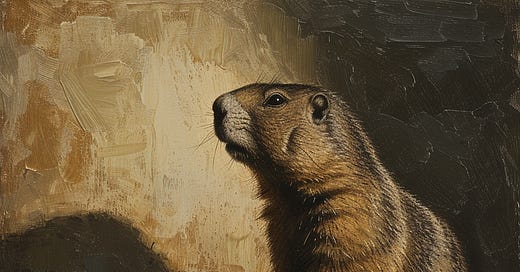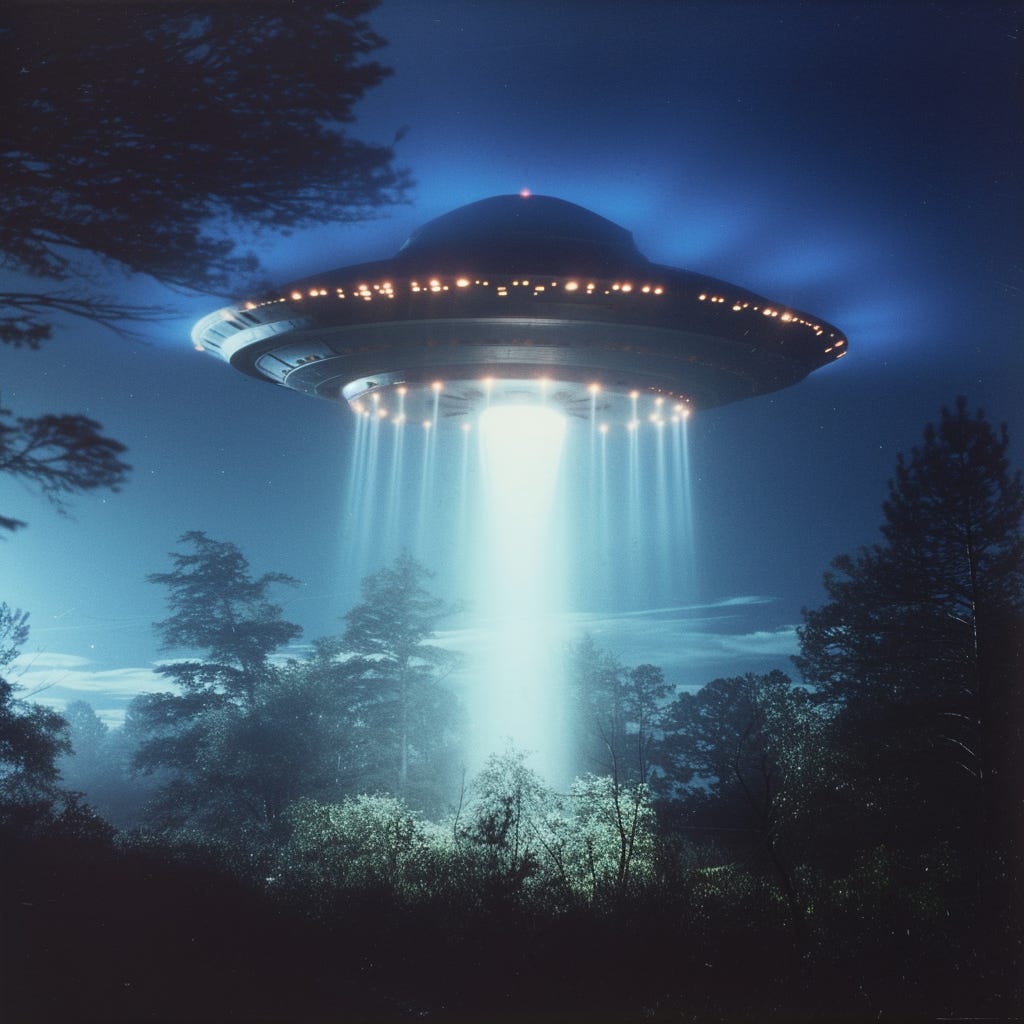Welcome back readers to the 2nd edition of Ratlinks for 2024. This February features a rare 29th day, enjoy this elongated month that also celebrates love and presidents.
This month’s edition touches on two topics: alien spacecrafts and art galleries.
BAD MOON RISING
UFOs, or Unidentified Flying Objects, have long stirred the collective curiosity of humanity, ranging from the convinced enthusiasts to the outright skeptics. Their presence in pop culture is as ubiquitous as the question of life beyond our own world.
An interplay between the unknown and the perceived limits of human knowledge—a confluence teeming with conspiracy theories, scientific inquiry, and an inexhaustible source of imaginative fiction. These days, the term UFO is often interchanged with UAP (Unidentified Aerial Phenomena), a more contemporary nomenclature favored in scientific and government circles, perhaps to shed the cultural baggage of "UFO."
The current view on UFOs is an ever-shifting tapestry, more nuanced than ever before. On one hand, there's the U.S. government's openly acknowledged interest, highlighted by the Pentagon's release of declassified videos and the institution of UAP-specific investigatory panels. This newfound transparency does not equate to any admittance of extraterrestrial origins but rather a recognition of phenomena that surpass our current understanding of physics or known technology, with implications for national security.
On the cultural front, where once the subject of UFOs might have been brushed off as fringe, there's a growing acceptance to at least consider the possibilities, nudged along by influential figures and scientific voices who are forefronting the discussion without fear of stigma.
A golf course isn't your usual UFO discourse hotspot, yet legend has it that Jordan Spieth quizzed President Obama mid-swing on whether aliens exist—a testament to our insatiable quest for answers to this question.
What if a UFO flew past Earth and we barely noticed?
In 2017, an unannounced guest veered into our solar system, an object so peculiar it was like seeing a float shaped like a giant Cuban cigar, tumbling end-over-end down Main Street.
Meet ‘Oumuamua — the Hawaiian name for a "scout" or a "messenger from afar arriving first." Discovered by a telescope in Hawaii, this interstellar traveler went down in history as the first visitor from another star system observed passing through our own. Unlike the familiar icy comets or stony space rocks we've been spotting through telescopes for ages, 'Oumuamua seemed to be cut from a different cosmic cloth.
This mysterious object was up to ten times longer than it was wide, resembling a cosmic needle barreling through our celestial neighborhood. Imagine a football field stretched thin and hurtling through space at speeds that would leave our fastest jets wheezing in the dust.
But it’s not just its shape that got our space-savvy friends scratching their heads; it was also the way it moved. As it slingshotted around the sun, 'Oumuamua seemed to give the laws of gravity the cold shoulder, accelerating in a way that sent scientists’ brows into a furrow. No comet’s been known to speed up without spitting out gas or dust, yet 'Oumuamua left nary a trail nor a cosmic crumb — as if an invisible force propelled it.
Was it an alien spacecraft?
A bizarre natural phenomenon?
A discarded cosmic candy wrapper?
Renowned astrophysicist Avi Loeb stirred the pot by suggesting that 'Oumuamua could be an artificial object — perhaps a probe from an advanced alien civilization, sailing through the stars on a reconnaissance mission.
I submit that the simplest explanation for these peculiarities is that the object was created by an intelligent civilization not of this Earth.
― Avi Loeb, Extraterrestrial: The First Sign of Intelligent Life Beyond Earth
Unfortunately, it was impossible to get a detailed picture, by the time it was seen by astronomers, 'Oumuamua was already well on its way back into the outer darkness. All you could see was a point, and after another eleven days, it could no longer be tracked.
'Oumuamua, with its interstellar intrigue, served as a reminder of the vast unknowns that await us beyond our planet, and the notion that visitors from other star systems can, and maybe do, drop by our little corner of the galaxy. It's an invitation to look up at the night sky with wonder and to keep our minds open to the boundless possibilities of what lies out there in the vastness of the universe
CURATE THIS
Becoming a gallerist with limited artistic talent.
According to OpenAI CEO Sam Altman in a few years, we will have a billion-dollar company with just one employee. Why not let AI help develop ideas into intricate hobbies or businesses?
Opening a gallery can be a journey as nuanced and varied as the art it aims to showcase. Whether you envision a sleek, modern space radiating with the work of avant-garde painters or a cozy nook brimming with local crafts, the process involves a mix of passion, planning, and pragmatism.
Whether you're keen on setting up a physical space or taking your gallery online, the journey starts with a clear idea of what you want to offer.
First, you must decide on the style or type of art you want to focus on – maybe it's contemporary paintings or perhaps digital art pieces.
All pictures in this piece are digitally generated, if interested please visit the full virtual gallery
At the core of a gallery's essence is the opportunity to foster creative talent. Emerging artists are continually seeking platforms to display their work, and as a gallery owner, you could be the bridge that connects these artists to the wider world. It’s in your exhibition spaces that a new artist could find their first collector, a critic’s praise, or a life-changing review. Watching an artist you believe in receiving recognition can be intensely gratifying, a feeling that often transcends even the monetary rewards of the business.
Galleries are not just commercial venues; they play an integral role in enriching the cultural landscape of a community. Places where people gather to experience the boundless interpretations of art, to learn, and to connect with others. Each exhibition you curate could spark discussions, bring people together, and introduce new concepts to the public discourse. This cultural contribution fosters a sense of achievement that comes with building something of lasting value to the community.
The art world thrives on a vibrant web of relationships, and owning a gallery puts you at the nexus of this network. Artists, collectors, critics, and enthusiasts all converge within your space, making every day an opportunity to meet fascinating individuals and foster relationships that can last a lifetime. These relationships can lead to exciting collaborations, offer new business opportunities, or even mentorship from more seasoned professionals in the art world.
Owning a gallery also comes with financial potential. Although the art market is famously unpredictable, savvy gallery owners can tap into trends, identify promising new artists, and realize significant profits from art sales. Additionally, art has the unique potential to appreciate over time, making well-chosen pieces not just decor but smart investments.
As a gallery owner, you'll enjoy curatorial freedom— the liberty to arrange pieces in a way that tells a story you want to tell, highlight issues you care about, or perhaps even reshape traditional narratives in art. This ability to manifest your vision into physical reality and share it with others can be one of the most rewarding aspects of gallery ownership.
Being constantly surrounded by art and interacting with those who value it yields deep, often immeasurable personal joy. For gallery owners, this continuous connection with a creative and innovative environment is a substantial source of satisfaction.
Moreover, galleries play a key role in community involvement. They serve as gathering spaces for art enthusiasts and can offer educational outreach, like school programs, thereby extending the gallery's influence beyond sales to become a cherished community asset.
One constant in the art world is change, and owning a gallery means being part of a never-ending process of education. With each new artist or exhibition, you'll discover new contexts, techniques, and stories. This keeps the gallery experience fresh and intellectually stimulating for both you and your visitors.
In today's reputation-driven market, owning a gallery allows you to build a distinctive brand. Your gallery can reflect your taste and vision, giving you room to grow into other areas such as design or lifestyle partnerships, which can expand your business and its reach. Your gallery's brand becomes a testament to your philosophy and style.
Finally, it's worth considering the long-term legacy of a gallery. For many owners, their gallery is a labor of love that will leave a mark on the cultural history of a place. It becomes a part of the tapestry of their own life story, potentially something to pass down to the next generation, ensuring that their name and passion for art live on.
Starting an art gallery, whether in a physical space or online, is about combining your passion for art with a smart business approach. It’s about creating a place where art enthusiasts can discover new favorite pieces and artists can find new audiences, all managed by you with attention and care. So if you're ready to step into this unique and exciting world, now is the time to get started.















